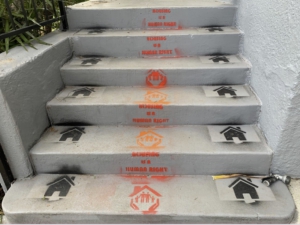On March 14, houseless protesters in Los Angeles took matters into their own hands. Calling themselves Reclaiming Our Homes, two families and a 64-year-old man moved into a vacant house owned by the State of California. Since their first action, 10 additional properties have been reclaimed by people desperately seeking shelter as COVID-19 continues to devastate Los Angeles.
Reclaimer Martha Escudero said she was inspired by Moms 4 Housing, a group of houseless mothers and their families who occupied a vacant house in Oakland to draw attention to the housing crisis in the Bay Area.
“We can’t wait for the government to do things for us. There’s families waiting in shelters for three years to be housed while the state is hoarding these houses,” Escudero said in an interview with BreakThrough News. “If the government is taking too long to meet the needs of the people, then the people need to form communities and take matters into their own hands.”
Unlike Moms 4 Housing, the protesters in Los Angeles aren’t fighting a company; instead, they’re going up against the state. Beginning in the 1950s, the California Department of Transportation (Caltrans) began purchasing hundreds of properties to make way for an extension of the 710 freeway in Los Angeles. Although the project lost funding and was effectively killed in 2018, an investigation by Pasadena Star News revealed that 163 of the state-owned homes along the 710 corridor continue to sit vacant and fall into disrepair.

When Escudero and the other Reclaimers heard city and state officials calling on people to self-quarantine to prevent the spread of coronavirus, they knew they had to act fast. Unsheltered people are particularly vulnerable during an outbreak, especially when social distancing and quarantine orders are in place to prevent the spread of the virus. This begs the question: How can people quarantine when they are experiencing homelessness?
Housing crisis out of control
California’s housing crisis has been spiraling out of control for decades. According to Zumper’s 2019 National Rent Report, half of the nation’s 10 most expensive rental markets are in California, with Los Angeles coming in at number five. LA County is home to approximately 59,000 people without permanent shelter — 33,000 of whom live in the city of Los Angeles — and housing advocates have spent years fighting a system that prioritizes profit over human life. Since the outbreak of COVID-19, that struggle for housing has reached a tipping point.
On March 11, Los Angeles County officials announced a moratorium on evictions to prevent the spread of coronavirus, and Mayor Eric Garcetti promised to convert the City’s recreation centers into temporary shelters, providing 6,000 more shelter beds for people experiencing homelessness — but even with the addition of 6,000 beds, over half of Angelenos experiencing homelessness will be left without shelter, forced to fend for themselves on the streets.
Capitalism’s failure to control the pandemic is one that is written into the system and cannot be legislated away. While Democrats and Republicans debate each other over which members of society are expendable and means test “solutions” to save capitalism during this pandemic, 18,895 people have died from coronavirus so far — but it is capitalism, not the virus, that has killed millions of people by withholding basic necessities such as food, shelter and health care.





